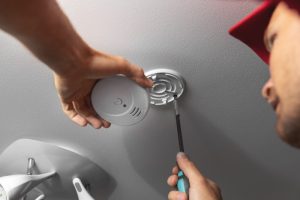Gas furnaces, in general, are quite safe. It is rare for anything to go terribly wrong. Sadly, though, it does occasionally happen that people are exposed to serious hazards because of their gas furnaces. The safety of our neighbors is our top priority, so we want to share some information that will help you prevent dangerous furnace problems.
The most likely way to be exposed to a serious hazard from your gas furnace is if your heat exchanger is cracked. What is a heat exchanger? Why would it crack? How can you make sure this doesn’t happen to your gas furnace? Read on to find out.
What the Heat Exchanger Does
Your gas furnace works via combustion. The gas has to explode and burn—in a controlled way, of course—to create the heat that warms your home. But the fumes of combustion are not safe to breathe. So how can this be going on safely inside your home? It’s all thanks to the heat exchanger!
This component is where the combustion gasses go. The fumes stay inside the heat exchanger, while air passes over and around it. This way, the heat can radiate from the heat exchanger and warm the air that will travel through the ducts and out the vents, but the dangerous gasses will be kept entirely separate from the air you breathe.
Why Heat Exchangers Crack
Your furnace works in cycles. It comes on when the temperature in your home gets low enough that the thermostat calls for heat. It turns off again when your home gets warm enough. That means the furnace itself is constantly heating up and cooling down, especially the heat exchanger. And when temperatures fluctuate like that, it causes metal to expand and contract.
A gas furnace can last for about fifteen years if it’s well-maintained. But that is a long time for the heat exchanger to constantly expand and contract. This will weaken the metal, making it more brittle. Eventually, the metal of the heat exchanger can crack.
How to Prevent Heat Exchanger Cracks
The best way to avoid this problem is to make sure you schedule regular heating system maintenance, every single year, ideally in the fall before you need to turn your furnace on for the first time. The technician will check over and closely inspect every component of the furnace. If the heat exchanger is not in great shape, the technician can make sure it gets replaced before it cracks.
How to Tell If Your Heat Exchanger Is Cracked
But what if there’s already a crack? How would you know? Keep an eye out for these signs: soot or moisture in the furnace cabinet, clicking and ticking sounds as the furnace cools down after a heating cycle, a flame that flickers or is any color other than blue, or visible corrosion. If your carbon monoxide detector goes off, the problem has already gotten quite bad, and you need to evacuate your home.
Make sure you keep your gas furnace in good condition! Schedule regular maintenance, and get gas furnace repair in Fredericksburg, TX right away if you have any concerns.
Contact D’Spain Sales & Service to talk to a member of our team.
















